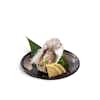


Nama Kaki Fuga (Sashimi Grade Whole Shell Oyster)
Large and plump
TASTING NOTES FROM THE CURATOR
A delicacy in Japan, these oysters from Iwate Prefecture are farmed and fresh, and are sashimi-grade, making it safe to eat them raw. This region is famous worldwide for its oysters, which become available in the spring, growing thrice as large than winter oysters. They are plump and firm, with a milky luster, and a sweet, succulent flavor.
PREPARATION AND PAIRINGS
Enjoy your Nama Kaki Fuga fresh, with some ponzu sauce or a squeeze of lemon juice. These oysters are also great to cook—try them steamed, grilled, baked, or in a hot pot. You can also enjoy it as nigiri or as gunkan maki. Another popular way to consume oysters in Japan is Kaki Furai, which involves breading then deep-frying your oysters.
OYSTER-CISM
The word oyster has a pretty interesting etymology. In ancient Greece, if the state decided that someone of power and influence was a threat to the stability of their society, they can undergo “ostracism.” A voting will occur in which voters would write a citizen’s name on a potsherd (a fragment of pottery or tile), and if a citizen received the most votes, they would be temporarily exiled. The word “ostracism” comes from the ancient Greek word “ostrakon” (or shell), and this is where the English word, oyster, comes from.
Storage Instructions
Store your box of fresh, unshucked oysters in your fridge, keeping the temperature between 0 to 5°C. Keep them covered with a damp cloth, flat side up, to increase shelf-life. To enjoy them at their freshest, please consume them within 48 hours.
When you’re ready to shuck your oysters, take a sharp knife (a vegetable knife or, ideally, an oyster shucking knife) and hold the oyster, round-side down and pointed side facing you, between a tea towel. Wiggle the knife into the pointy end and twist it until the shell comes open.





